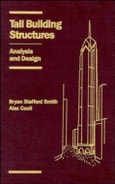Examines structural aspects of high rise buildings, particularly fundamental approaches to the analysis of the behavior of different forms of building structures including frame, shear wall, tubular, core and outrigger-braced systems. Introductory chapters discuss the forces to which the structure is subjected, design criteria which are of the greatest relevance to tall buildings, and various structural forms which have developed over the years since the first skyscrapers were built at the turn of the century. A major chapter is devoted to the modeling of real structures for both preliminary and final analyses. Considerable attention is devoted to the assessment of the stability of the structure, and the significance of creep and shrinkage is discussed. A final chapter is devoted to the dynamic response of structures subjected to wind and earthquake forces. Includes both accurate computer-based and approximate methods of analysis.
Table of Contents
Tall Buildings.Design Criteria.
Loading.
Structural Form.
Modeling for Analysis.
Braced Frames.
Rigid-Frame Structures.
Infilled-Frame Structures.
Shear Wall Structures.
Coupled Shear Wall Structures.
Wall-Frame Structures.
Tubular Structures.
Core Structures.
Outrigger-Braced Structures.
Generalized Theory.
Stability of High-Rise Buildings.
Dynamic Analysis.
Creep, Shrinkage, and Temperature Effects.
Appendices.
Bibliography.
Index.








